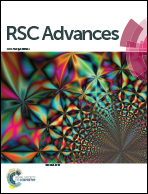Cytocompatible antibacterial fibrous membranes based on poly(3-hydroxybutyrate-co-4-hydroxybutyrate) and quaternarized N-halamine polymer
Abstract
A novel polymeric N-halamine-containing quaternary ammonium salt (PHQS) was synthesized and used to make antibacterial electrospun fibrous membranes by blending with biodegradable poly(3-hydroxybutyrate-co-4-hydroxybutyrate) (P(3HB-4HB)). The chemical structures of 3-(2′-chloroethyl)-5,5-dimethylhydantoin (CEDMH), poly(2-(dimethylamino)ethyl methacrylate) (PDMAEMA) and PHQS were characterized with FT-IR, 1H NMR, 13C NMR and GPC. The obtained electrospun fibrous membranes were chlorinated with chlorine bleach and characterized by scanning electron microscopy (SEM) and thermogravimetry (TG). The new fibrous membranes provided potent antimicrobial activities against Gram-positive Staphylococcus aureus and Gram-negative Escherichia coli O157:H7. In addition, the treated electrospun fibrous membranes showed excellent stability and durability in UVA light irradiation and storage tests. The results of rat skin fibroblast cytotoxicity studies indicated that the antimicrobial membranes are biocompatible. From this research, polymeric quaternarized N-halamine antimicrobial fibrous membranes based on P(3HB-4HB) may have potential use as eco-friendly materials in food packaging and biomedicine.


 Please wait while we load your content...
Please wait while we load your content...